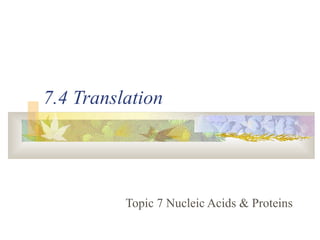
7.4 translation
- 1. 7.4 Translation Topic 7 Nucleic Acids & Proteins
- 2. Translation 7.4.1 Explain that each tRNA molecule is recognized by a tRNA-activating enzyme that binds a specific amino acid to the tRNA, using ATP for energy. Each amino acid has a specific tRNA-activating enzyme (the name aminoacyl-tRNA synthetase is not required). The shape of tRNA and CCA at the 3’ end should be included. 7.4.2 Outline the structure of ribosomes, including protein and RNA composition, large and small subunits, three tRNA binding sites and mRNA binding sites.
- 3. Translation 7.4.3 State that translation consists of initiation, elongation, translocation and termination. 7.4.4 State that translation occurs in a 5’→ 3’ direction. During translation, the ribosome moves along the mRNA towards the 3’ end. The start codon is nearer to the 5’ end. 7.4.5 Draw and label a diagram showing the structure of a peptide bond between two amino acids.
- 4. Translation 7.4.6 Explain the process of translation, including ribosomes, polysomes, start codons and stop codons. Use of methionine for initiation, details of the T factor and recall of actual stop codons are not required. 7.4.7 State that free ribosomes synthesize proteins for use primarily within the cell, and that bound ribosomes synthesize proteins primarily for secretion or for lysosomes.
- 5. The Structure of tRNA Translation involves reading the mRNA in sets of 3 nucleotides called codons. There are 61 codons (excluding 3 stop codons) for the 20 amino acids. This also means there are 61 anticodons and hence 61 different types of tRNA This is called the triplet code. Since there are only 20 amino acids, the triplet code allows for degeneracy. (more than one tRNA per amino acid.
- 6. The Structure of tRNA Transfer RNA (tRNA) has a vital role in translating the genetic code: All tRNA molecules have: A triplet of bases called the anticodon,in a loop of 7 nucleotides. Two side loops. The base sequence CCA at the 3’ terminal, which forms a site for attaching an amino acid. Sections that become double stranded by complementary base pairing. These features allow all tRNA molecules to bind to sites on the ribosome and mRNA. Ref: Biology for the IB Diploma, Allott
- 7. tRNA Activating Enzymes The variable features of each tRNA molecule give them a distinctive 3 dimensional shape. This allows the correct amino acid to be attached to the 3’ terminal by an enzyme called the tRNA activating enzyme. There are 20 different tRNA activating enzymes (one for each of the 20 amino acids). Each enzyme attaches one particular amino acids to all of the tRNA molecules that have an anticodon corresponding to that amino acid. Energy from ATP is needed for the attachment of amino acids. The reaction of joining an amino acid to the tRNA is a condensation reaction, producing water.
- 8. tRNA Activating Enzymes Ref: IB Biology HL, OSC
- 9. Ribosome Structure Ribosomes have a complex structure; Proteins and ribosomal RNA molecules both form part of the structure. There are 2 subunits, one large and one small. There are binding sites for tRNA on the surface of the ribosome allow 2 tRNA molecules to bind at the same time. There is a binding site for mRNA on the surface of the ribosome Ref: Biology for the IB Diploma, Allott
- 10. Translation Messenger RNA carries the information needed for making polypeptides. The information is in a code form, which is decoded during the the process of translation. Ribosomes, tRNA molecules and tRNA activating enzymes are needed to carry out this decoding. There are 3 main stages in Translation: Initiation Elongation Termination Like DNA replication, translation occurs in a 5’ 3’ direction.
- 14. Polysomes Many polypeptides are needed in large quantities eg: enzymes, antibodies, hormones. It would be energetically inefficient for one mRNA to synthesise a single polypeptide. Thus as a ribosome moves along the mRNA another one can join on behind it and so on like beads on a string. Multiple copies of the polypeptide can be synthesised rapidly.
- 15. Ribosomes The distribution of ribosomes within the cell depends upon the function of the protein they make. Some ribosomes are found bound to the endoplasmic reticulum while other float free within the cytoplasm. Bound ribosomes produce proteins which are to be secreted out of the cell or for use in lysosomes. Free ribosomes synthesise proteins for use primarily within the cell.
- 16. Translation 7.4.1 Explain that each tRNA molecule is recognized by a tRNA-activating enzyme that binds a specific amino acid to the tRNA, using ATP for energy. Each amino acid has a specific tRNA-activating enzyme (the name aminoacyl-tRNA synthetase is not required). The shape of tRNA and CCA at the 3’ end should be included. 7.4.2 Outline the structure of ribosomes, including protein and RNA composition, large and small subunits, three tRNA binding sites and mRNA binding sites.
- 17. Translation 7.4.3 State that translation consists of initiation, elongation, translocation and termination. 7.4.4 State that translation occurs in a 5’→ 3’ direction. During translation, the ribosome moves along the mRNA towards the 3’ end. The start codon is nearer to the 5’ end. 7.4.5 Draw and label a diagram showing the structure of a peptide bond between two amino acids.
- 18. Translation 7.4.6 Explain the process of translation, including ribosomes, polysomes, start codons and stop codons. Use of methionine for initiation, details of the T factor and recall of actual stop codons are not required. 7.4.7 State that free ribosomes synthesize proteins for use primarily within the cell, and that bound ribosomes synthesize proteins primarily for secretion or for lysosomes.